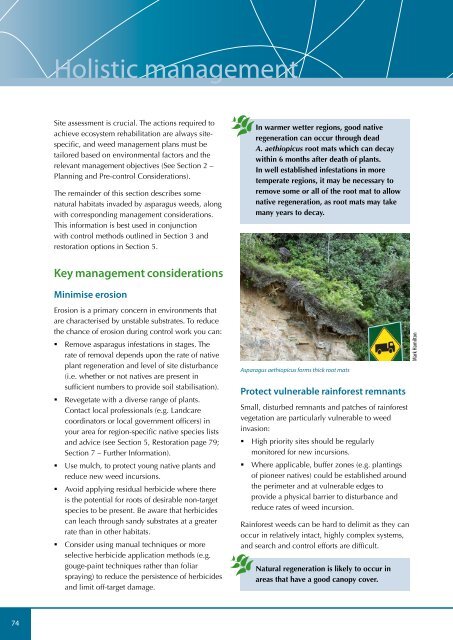Asparagus weeds - Weeds Australia
Asparagus weeds - Weeds Australia
Asparagus weeds - Weeds Australia
- No tags were found...
You also want an ePaper? Increase the reach of your titles
YUMPU automatically turns print PDFs into web optimized ePapers that Google loves.
Holistic managementSite assessment is crucial. The actions required toachieve ecosystem rehabilitation are always sitespecific,and weed management plans must betailored based on environmental factors and therelevant management objectives (See Section 2 –Planning and Pre-control Considerations).The remainder of this section describes somenatural habitats invaded by asparagus <strong>weeds</strong>, alongwith corresponding management considerations.This information is best used in conjunctionwith control methods outlined in Section 3 andrestoration options in Section 5.In warmer wetter regions, good nativeregeneration can occur through deadA. aethiopicus root mats which can decaywithin 6 months after death of plants.In well established infestations in moretemperate regions, it may be necessary toremove some or all of the root mat to allownative regeneration, as root mats may takemany years to decay.Key management considerationsMinimise erosionErosion is a primary concern in environments thatare characterised by unstable substrates. To reducethe chance of erosion during control work you can:• Remove asparagus infestations in stages. Therate of removal depends upon the rate of nativeplant regeneration and level of site disturbance(i.e. whether or not natives are present insufficient numbers to provide soil stabilisation).• Revegetate with a diverse range of plants.Contact local professionals (e.g. Landcarecoordinators or local government officers) inyour area for region-specific native species listsand advice (see Section 5, Restoration page 79;Section 7 – Further Information).• Use mulch, to protect young native plants andreduce new weed incursions.• Avoid applying residual herbicide where thereis the potential for roots of desirable non-targetspecies to be present. Be aware that herbicidescan leach through sandy substrates at a greaterrate than in other habitats.• Consider using manual techniques or moreselective herbicide application methods (e.g.gouge-paint techniques rather than foliarspraying) to reduce the persistence of herbicidesand limit off-target damage.<strong>Asparagus</strong> aethiopicus forms thick root matsProtect vulnerable rainforest remnantsSmall, disturbed remnants and patches of rainforestvegetation are particularly vulnerable to weedinvasion:• High priority sites should be regularlymonitored for new incursions.• Where applicable, buffer zones (e.g. plantingsof pioneer natives) could be established aroundthe perimeter and at vulnerable edges toprovide a physical barrier to disturbance andreduce rates of weed incursion.Rainforest <strong>weeds</strong> can be hard to delimit as they canoccur in relatively intact, highly complex systems,and search and control efforts are difficult.Natural regeneration is likely to occur inareas that have a good canopy cover.Mark Hamilton74
















